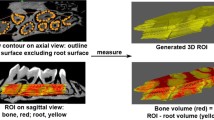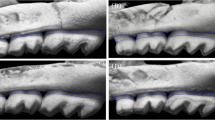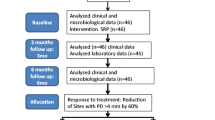Abstract
Objective
The study aimed to investigate the effect of alendronate (ALN) on the inhibition of alveolar bone loss in experimental periodontitis in Wistar rats.
Materials and methods
Periodontitis was induced by oral inoculation of Porphyromonas gingivalis with Fusobacterium nucleatum. The rats (n = 80) were randomized as follows: negative control (n = 10); positive control (n = 10); ALN groups: test 8 (n = 10), test 12 (n = 10), and test 16 (n = 10); and placebo groups: control 8 (n = 10), control 12 (n = 10), and control 16 (n = 10). Two milligrams per kilogram of ALN or placebo was administered twice weekly for 8, 12, and 16 weeks. Bone loss was determined by morphological and histological analyses. One independent, blinded examiner (ICC, 0.91) performed the measurements. The distance from the cement enamel junction to the alveolar bone crest of the second lower molar was measured: distal-vestibular (d), furca (f), mesial-vestibular (h), and area. Histometry was performed on the second contralateral molar. Sections (6 μm) were used to determine the furcation bone area (A-FB). The following statistical analyses were conducted: Mann-Whitney and Kruskal-Wallis.
Results
PC group developed periodontitis (p < 0.0001). Morphometric analysis determined that ALN was effective in T8 for linear measurements d, f, and h (p < 0.05). No significant differences occurred at test 8, test 12, and test 16. Analysis of A-FB revealed no significant differences between the ALN and placebo groups at 8 and 16 weeks (p > 0.05). ALN was effective against bone loss in relation to A-FB after 12 weeks (p < 0.0001).
Conclusions
According to the methodology used, the results suggest that oral administration of ALN could influence alveolar bone loss in rats submitted to experimental periodontitis.
Clinical relevance
ALN could be a potential therapeutic approach when associated with periodontal treatment.




Similar content being viewed by others
References
Ito M, Amizuka N, Nakajima T, Ozawa H (1999) Ultrastructural and cytochemical studies on cell death of osteoclasts induced by bisphosphonate treatment. Bone 25:447–452
Chun YH, Foster BL, Lukasavage PA, Berry JE, Zhao M, Tenenbaum HC, et al. (2005) Bisphosphonate modulates cementoblast behavior in vitro. J Periodontolol 76:1890–1900
Jeffcoat MK (2006) Safety of oral bisphosphonates: controlled studies on alveolar bone. Int J Oral Maxillofac Implants 21:349–353
Rodan GA (1998) Mechanism of action of bisphosphonates. Annu Rev Phamacol Toxicol 38:357–388
Brown DL, Robbins R (1999) Developments in the therapeutic applications of bisphosphonates. J Clin Pharmacol 39:651–660
Yaffe A, Kollerman R, Bahar H, Binderman I (2003) The influence of alendronate on bone formation and resorption in a rat ectopic bone development model. J Periodontol 74:44–50
Black MD, Schwartz AV, Ensrud KE (2006) Effects on continuing stopping alendronate after 5 years of treatment: the fracture intervention trial long-term extention (FLEX): a randomized trial. JAMA 296:2927–2938
Reid IR, Hosking DJ (2011) Bisphosphonates in Paget’s disease. Bone 49:89–94
Fleisch H (1991) Bisphosphonates. Pharmacology and use in the treatment of tumor-induced hypercalcaemic and metastatic bone disease. Drugs 42:919–944
Senaratne SG, Pirianov G, Mansi JL, Arnett TR, Colston KW (2000) Bisphosphonates induce apoptosis in human breast cancer cell lines. Br J Cancer 82:1459–1468
Williamson R (2010) Bisphosphonates and the dental practitioner—a guide to management. Ann R Australas Coll Dent Surg 20:46–9.
Ruggiero SL, Fantasia J, Carlson E (2006) Bisphosphonate-related osteonecrosis of the jaw: background and guidelines for diagnosis, staging and management. Oral Surg Oral Med Oral Pathol Oral Radiol Endod 102:433–441
Aghaloo TL, Kang B, Sung EC, Shoff M, Ronconi M, Gotcher JE, Bezouglaia O, Dry SM, Tetradis S (2011) Periodontal disease and bisphosphonates induce osteonecrosis of the jaws in the rat. J Bone Miner Res 26:1871–1882
Sharma D, Ivanovski S, Slevin M, Hamlet S, Pop TS, Brinzaniuc K, Petcu EB, et al. (2013) Bisphosphonate-related osteonecrosis of jaw (BRONJ): diagnostic criteria and possible pathogenic mechanisms of an unexpected anti-angiogenic side effect. Vascullar Cell 5:1–8
Brunsvold MA, Chaves SE, Kornman KS, Aufdemorte TB, Wood R (1992) Effects of a bisphosphonate on experimental periodontitis in monkeys. J Periodontol 63:825–830
Tani-ishii N, Minamida G, Saitoh D, Chieda K, Omuro H, Sugaya A, et al. (2003) Inhibitory effects of incadronate on the progression of rat experimental periodontitis by Porphyromonas gingivalis infection. J Periodontol 74:603–609
Meneses AM, Rocha FA, Chaves HV, Carvalho CB, Ribeiro RA, Brito GC (2005) Effect of sodium alendronate on alveolar bone resorption in experimental periodontitis in rats. J Periodontol 76:1901–1909
Spolidorio SC, Marcantonio E Jr, Spolidorio DMP, Nassar CA, Nassar PO, Marcantonio RA, et al. (2007) Alendronate therapy in cyclosporine-induced alveolar bone loss in rats. J Periodont Res 42:466–473
Jeffcoat MK, Cizza G, Shih WJ, Genco R, Lombardi A (2007) Efficacy of bisphosphonates for the control of alveolar bone in periodontitis. J Int Acad Periodontol 9:70–73
Shinoda H, Takeyama S, Suzuki K, Murakami S, Yamada S (2008) Pharmacological topics of bone metabolism: a novel bisphosphonate for the treatment of periodontitis. J Pharmacol Sci 106:555–558
Kanis JA, Burlet N, Cooper C, Delmas PD, Reginster J-Y, Borgstrom F, et al. (2008) European guidance for the diagnosis and management of osteoporosis in postmenopausal women. Osteoporos Int 19:399–428
Gupta J, Gill AS, Sikri P (2011) Evaluation of the relative efficacy of an alloplast used alone and in conjunction with an osteoclast inhibitor in the treatment of human periodontal infrabony defects: a clinical and radiological study. Indian J Dent Res 22:225–231
Weinreb MQ, Quartuccio H, Seedor JG, Aufdemorte TB, Brunsvold M, Chaves E, et al. (1994) Histomorphometrical analysis of the effects of the bisphosphonate alendronate on bone loss caused by experimental periodontitis in monkey. J Periodontot Res 29:35–40
Duarte P, De Assis DR, Casati MZ, Sallum AW, Sallum EA, Nociti FH Jr (2004) Alendronate may protect against increased periodontitis-related bone loss in estrogen-deficient rats. J Periodontol 75:1196–1202
Reddy MS, Weatherford TW 3rd, Smith CA, West BD, Jeffcoat MK, Jacks TM (1995) Alendronate treatment of naturally-occurring periodontitis in beagle dogs. J Periodontol 66:211–217
Kesavalu L, Sathishkumar S, Bakthavatchalu V, Matthews C, Dawson D, Steffen M, et al. (2007) Rat model of polymicrobial infection, immunity, and alveolar bone resorption in periodontal disease. Infect Immun 75:1704–1712
Storrer CM, Aun CJ, Pustiglioni FE, Romito GA (2010) Periodontal disease induced by Porphyromonas gingivalis and Fusobacterium nucleatum in Wistar rats. Arq Odontol 46:185–189
Duncan MJ (2005) Oral microbiology and genomics. Periodontol 2000(38):63–71
Rivaldo EG, Padilha DP, Hugo FN (2005) Alveolar bone loss and aging: a model for study in mice. J Periodontol 76:1966–1971
Kuhr A, Popa-Wagner A, Schmoll H, Schwahn C, Kocher T (2004) Observations on experimental marginal periodontitis in rats. J Periodontal Res 39:101–106
Deliberador TM, Nagata MJH, Furlaneto FAC, Melo LGN, Okamoto T, Sundefeld MM, et al. (2006) Autogenous bone graft with or without a calcium sulfate barrier in the treatment of class II furcation defects: a histologic and histometric study in dogs. J Periodontol 77:780–789
Baker J, Dixon M, Roopenian DC (2000) Genetic control of susceptibility to Porphyromonas gingivalis-induced alveolar bone loss in mice. Infect Immunol 68:5864–5868
Zubery Y, Dunstan CR, Story BM, Kesavalu L, Ebersole JL, Holt SC, et al. (1998) Bone resorption caused by three periodontal pathogens in vivo in mice is mediated in part by prostaglandin. Infect and Immun 66:4158–4162
Shoji K, Horiuchi H, Shinoda H (1995) Inhibitory effects of a bisphosphonate (risedronate) on experimental periodontitis in rats. J Periodontal Res 30:277–284
Meulman T, Peruzzo DC, Stipp RN, Gonçalves PF, Sallum EA, Casati MZ, Goncalves RB, Nociti FH Jr (2011) Impact of Porphyromonas gingivalis inoculation on ligature-induced alveolar bone loss. A pilot study in rats. J Periodontal Res 46:629–636
Rossini M, Gatti D, Zamberlan N, Braga V, Dorrizi R, Adami S (1994) Long-term effect of treatment course with oral alendronate of postmenopausal osteoporosis. J Bone Miner Res 9:1833–1837
Giuliani N, Pedrazzoni M, Passeri G, Girasole G (1998) Bisphosphonates inhibit IL-6 production by human osteoblast-like cells. Scand J Rheumatol 27:38–41
Crawford JM, Taubman MA, Smith DJ (1978) The natural history of periodontal bone loss in germfree and gnotobiotic rats infected with periodontopathic microorganisms. J Periodontol Res 13:316–325
Klausen B, Evans RT, Sfintescu C (1989) Two complementary methods of assessing periodontal bone level in rats. Scand J Dent Res 97:494–499
Alencar VBM, Bezerra MM, Lima V, Abreu ALC, Brito GAC, Rocha FAC, et al. (2002) Disodium chlodronate prevents bone resorption in experimental periodontitis in rats. J Periodontol 73:251–256
Holt SC, Ebersole JL (2005) Porphyromonas gingivalis, Treponema denticola, and Tannerella forsythia: the “red complex”, a prototype polybacterial pathogenic consortium in periodontitis. Periodontol 2000(38):78–122
Tipton DA, Seshul BA, Dabbous MK (2011) Effect of bisphosphonates on human gingival fibroblast production of mediators of osteoclastogenesis: RANKL, osteoprotegerin and interleukin-6. J Periodont Res 46:39–47
Moreira MM, Bradaschia-Correa V, Marques ND, Ferreira LB, Arana-Chavez VE (2014) Ultrastructural and immunohistochemical study of the effect of sodium alendronate in the progression of experimental periodontitis in rats. Microsc Res Tech 77:902–909
Author information
Authors and Affiliations
Corresponding author
Ethics declarations
Conflict of interest
The authors declare that they have no conflict of interest.
Funding
The work was supported by Positivo University, Paraná, Brazil.
Ethical approval
This research was approved by the Ethics in Research Committee of Positivo University with the agreement of Animal Bioethics Subcommission of the Faculty of Odontology of the University of São Paulo.
Informed consent
For this type of study, formal consent is not required.
Rights and permissions
About this article
Cite this article
Storrer, C.L.M., Deliberador, T.M., Giovanini, A.F. et al. Effect of alendronate on the progression of periodontitis induced by Porphyromonas gingivalis and Fusobacterium nucleatum: a study in rats. Clin Oral Invest 20, 2565–2573 (2016). https://doi.org/10.1007/s00784-016-1769-4
Received:
Accepted:
Published:
Issue Date:
DOI: https://doi.org/10.1007/s00784-016-1769-4




